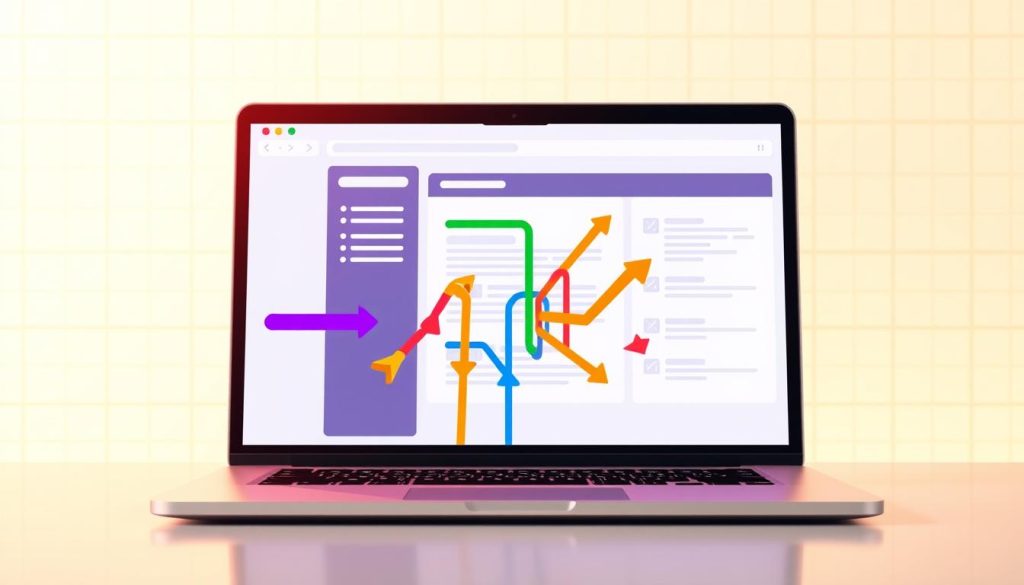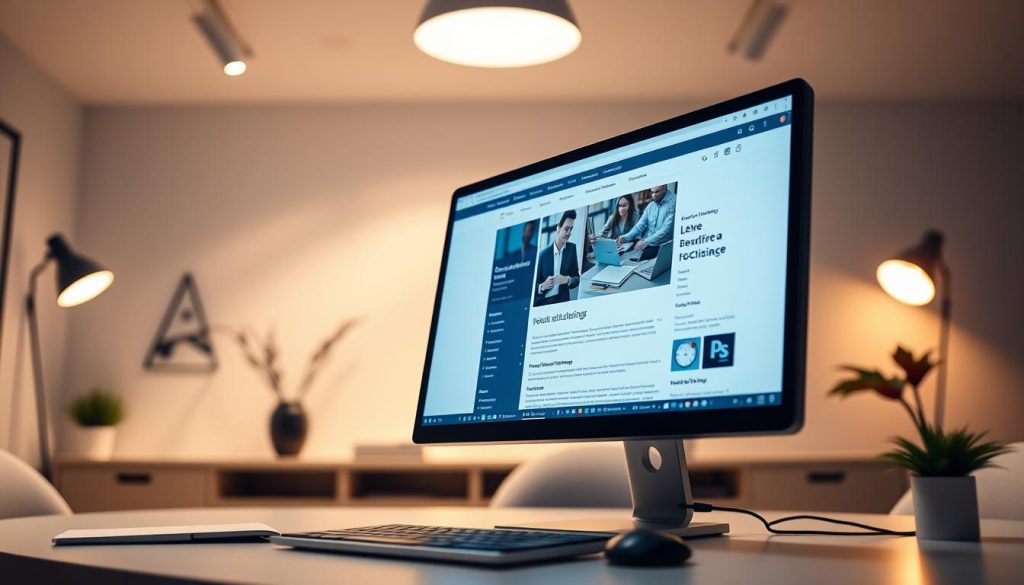Welcome to your guide on a powerful SEO strategy. This technique quietly strengthens your website’s performance. It connects your pages in a smart way. This helps both search engines and visitors find their way around.
Think of this method as a roadmap for Google. Every link helps search engines find, index, and understand your pages. At the same time, it guides readers to relevant content. This keeps them engaged and shows your site has real value.
This is about more than just connecting pages. It’s a strategic approach. It enhances how easily your site can be crawled. It improves rankings and builds your topical authority. Most importantly, it creates a better experience for people.
You will learn how this strategy distributes authority across your site. It helps define your site’s hierarchy. It can lower bounce rates and increase the time people spend with your content. This all contributes to better search results.
This might sound technical, but it’s actually quite straightforward. It’s one of the most impactful things you can do for your website. You can do it no matter your technical skill level.
Table of Contents
Key Takeaways
- Internal linking acts as a roadmap for search engines to discover and index your site.
- It helps guide visitors to relevant content, improving user experience.
- A good strategy distributes authority and value throughout your website.
- It helps search engines understand the structure and hierarchy of your pages.
- Effective linking can reduce bounce rates and increase dwell time.
- This is a powerful SEO technique accessible to website owners of all skill levels.
Understanding the Basics of Internal Linking
The foundation of any successful website structure begins with understanding how pages interconnect. These connections serve as pathways that guide both visitors and search engines through your content.
What Are Internal Links?
Internal links are hyperlinks that connect different pages within the same website. They appear as clickable text or buttons that transport users to related content without leaving your domain.
Here’s a simple example of how these links look in HTML code: <a href="https://www.yoursite.com/page">anchor text</a>. When properly implemented, they create a web of interconnected content that search engines can easily crawl.
If a page lacks these connections, it becomes « orphaned » and may never be discovered by search engines. This makes internal linking essential for visibility.
Difference Between Internal and External Links
Internal links keep visitors within your website, helping them explore related topics and find valuable information. They also distribute authority throughout your pages.
External links, however, point to other websites. They provide credibility by citing sources and offering additional context. Both types serve important roles in a comprehensive linking strategy.
Understanding this distinction helps you create balanced navigation that benefits both users and search engines.
Benefits of a Strong Internal Linking Structure
The true power of well-planned page connections reveals itself through multiple performance improvements across your entire site. These connections work like a well-organized filing system that benefits both technology and people.

Enhanced Crawlability and Indexing
Search engines follow pathways between your pages to discover content. A solid linking structure ensures all your valuable pages get found and indexed properly. This prevents important content from staying hidden.
Improved Search Rankings and Authority
Strategic connections distribute authority from popular pages to newer content. This transfer of SEO strength helps less visible pages rank better. Your entire site gains more visibility in search results.
Boosted User Engagement and Navigation
Visitors appreciate clear pathways to related information. Good linking keeps users exploring your content longer. This positive engagement signals to search engines that your content provides real value.
Key Types of Internal Links to Enhance Navigation
Not every link on your site has the same job. Understanding their roles is key to a great navigation system. Different types guide users and search engines in unique ways.
We can group these essential connectors into a few main categories. Each one serves a distinct purpose for your visitors and your SEO.
Navigational and Contextual Links
Navigational links live in your main menu. They help people find key sections like Home, About, or Blog quickly. These links also show search engines your most important pages.
Contextual links appear within your body text. They naturally guide readers to related topics. This type carries strong SEO value by showing topical relevance between pages.
Footer, Sidebar, and Breadcrumb Links
Footer links sit at the bottom of your web pages. They often point to legal or informational content. While less powerful for SEO, they aid overall site crawlability.
Sidebar links appear next to your main content. They might showcase recent posts or popular articles. This helps users discover more relevant information easily.
Breadcrumb links show a page’s location in your site hierarchy. They look like Home > Blog > SEO Tips. This helps everyone understand their current position.
| Link Type | Primary Purpose | Typical Location | SEO Value | User Benefit |
|---|---|---|---|---|
| Navigational | Access key site sections | Header/Menu | High (Site Structure) | Quick access to main areas |
| Contextual | Guide to related topics | Within body text | Very High (Relevance) | Deeper content exploration |
| Footer | Link to utility pages | Page bottom | Medium (Crawlability) | Access to legal/contact info |
| Sidebar | Highlight additional content | Alongside main content | Medium (Engagement) | Discover related articles |
| Breadcrumb | Show page location | Top of page | Medium (Hierarchy) | Easy navigation back |
Using a mix of these types creates a robust system. It serves both human visitors and search engine crawlers effectively.
Implementing an Internal Linking Strategy for SEO
Strategic implementation of page connections is where theory meets practice in website optimization. This phase transforms your planning into tangible results that boost visibility.
Before diving into specific techniques, consider your overall approach. A clear roadmap ensures every element works together harmoniously.
Developing a Targeted Linking Blueprint
Start by mapping your site’s hierarchy. Identify your most important pages that deserve priority attention.
These typically include your homepage, key service offerings, and main blog categories. Then list supporting content like specific articles and FAQ sections.
Your blueprint should connect high-authority pages with those needing an SEO boost. This strategic flow distributes value throughout your entire website.

Selecting Keyword-Rich Anchor Text
The clickable phrase in your hyperlink tells search engines what the destination page is about. Choose descriptive words that match the target content.
Unlike external backlinks, you can safely use exact-match phrases for your site’s connections. However, variety remains important for natural appearance.
« Descriptive anchor text helps both users and search engines understand the context of your links. »
Effective anchor text follows these principles. It should be brief, relevant, and clearly indicate where the link leads.
| Good Examples | Poor Examples | Reason |
|---|---|---|
| best coffee machines | click here | Descriptive vs vague |
| SEO guide for beginners | read more | Specific vs generic |
| website pricing plans | this page | Clear vs ambiguous |
Always use unique phrases for different destination pages. This prevents confusion about which content should rank for specific terms.
Proper implementation of these techniques significantly impacts your search engine ranking. Consistent application builds a strong foundation for long-term success.
How Search Engines Grasp Your Site Structure
Search engines need clear signals to understand your website’s organization. They rely on the connections between your pages to map out relationships and determine importance.
When crawlers visit your site, they follow pathways between content. This process helps search engines recognize topic clusters and content depth.
Crawlability and Mapping Relationships
Crawlability refers to how easily search engine bots can access your pages. These connections serve as the primary navigation system for crawlers.
Think of your homepage as the main entrance. When it connects to category pages, and those link to specific product pages, you create a clear hierarchy. This signaling helps search engines understand which pages carry the most weight.
Google’s crawlers discover new content by following these pathways. As they explained: « Some pages are known because Google has already crawled them before. Other pages are discovered when Google follows a link from a known page to a new page. »
Passing Authority and Distributing Link Equity
Your homepage typically carries the highest authority because it earns the most external backlinks. When you strategically connect it to other important pages, some of that value flows through.
This transfer of PageRank strengthens destination pages throughout your site. However, only a portion of authority passes through each connection.
Contextual relevance matters significantly for effective authority distribution. Connections work best when they align with user needs and connect topically related content.
Proper site organization helps search engines understand semantic connections between pages. This becomes increasingly important as algorithms focus on comprehensive topic understanding rather than individual keyword matching.
Enhancing User Experience Through Smart Internal Linking
When visitors find exactly what they need without frustration, your website transforms from a collection of pages into a helpful resource. Smart connections create pathways that guide people smoothly through your content.
Guiding Visitors to Related Content
Strategic placement of connections helps users discover valuable information. Place relevant links within your body text where they naturally fit.

This approach gives visitors something meaningful to click on right away. They can explore deeper into topics that interest them.
Reducing Bounce Rates and Increasing Dwell Time
When people leave after viewing only one page, it signals missed opportunities. Well-placed connections encourage further exploration.
This increases the time people spend on your site. Search engines notice this positive engagement.
Visitors who find your content useful are more likely to return. They might even share your site with others.
Think about the natural journey someone takes when learning about a topic. Your connections should support this flow.
Leveraging Yoast SEO and Other Tools for Internal Linking
Managing your website’s connections manually becomes increasingly challenging as your content library expands. Fortunately, specialized tools can automate this process while maintaining strategic quality.
Yoast SEO Premium stands out as a powerful WordPress plugin that simplifies connection management. Its smart suggestion feature analyzes your content as you write, recommending relevant pages for natural integration.
Utilizing Yoast’s Internal Linking Suggestions
The plugin’s drag-and-drop interface makes adding connections effortless. You no longer need to search through old articles manually—relevant suggestions appear directly in your editor.
Yoast offers specialized blocks that enhance site navigation. The Breadcrumbs block helps users understand their location within your site hierarchy. Related links blocks automatically display connected articles.
« Automated suggestions save time while ensuring consistent connection patterns across your entire site. »
The tool provides valuable overviews of your connection distribution. You can quickly identify pages needing more attention or those with excessive links.
| Tool | Primary Function | Best For | Integration |
|---|---|---|---|
| Yoast SEO Premium | Real-time suggestions | WordPress users | Direct editor integration |
| Screaming Frog | Technical audit | Comprehensive analysis | Desktop application |
| Semrush Site Audit | SEO management | All-in-one solution | Cloud-based platform |
These tools help prevent orphaned pages by identifying content without connections. They scale effectively as your blog grows, maintaining optimal site structure.
Remember that tools should complement rather than replace strategic thinking. Combine automated efficiency with human judgment for the best results.
Building Content Hubs and Topic Clusters
Content hubs represent the next evolution in strategic website organization. This approach groups related material around central themes, creating organized knowledge centers that benefit both visitors and search engines.
Identifying Pillar Pages and Supporting Content
Start by finding your cornerstone content. These pillar pages cover broad topics comprehensively. They serve as the main entry point for a subject area.
Your supporting cluster content explores specific aspects of the main topic. Each cluster page dives deep into subtopics and long-tail keywords. This creates a natural hierarchy of information.
Interlinking Cluster Pages for Topical Relevance
Connect your cluster pages back to the main pillar page. Also link related cluster pages together when appropriate. This creates a web of contextually connected material.
For example, a pillar page about « coffee machines » might connect to cluster pages about specific models, maintenance tips, and buying guides. Each piece supports the others through strategic connections.
This approach signals to search engines that you offer comprehensive coverage. It also helps users explore topics completely without leaving your site.
Auditing and Optimizing Your Internal Links
A healthy website requires regular check-ups, just like a car needs an oil change. Your network of connections needs the same attention to stay in top shape. Regular audits help you find and fix problems before they hurt your SEO.
Use tools like Google Search Console or Screaming Frog to scan your site. These tools show you which pages are connected and how deep they are in your site’s structure.
Identifying Broken or Orphaned Links
Broken links lead to dead ends, creating a poor experience for visitors and search engines. They point to pages that no longer exist, resulting in 404 errors.
Orphaned pages are even trickier. These are pages with no connections pointing to them. Search engines may never find them, leaving your valuable content hidden.
Fixing Crawl Depth and Redirect Issues
Crawl depth is the number of clicks it takes to reach a page from your homepage. If a page is buried too deep, it might be seen as less important.
Redirect chains and loops can also slow down crawlers. Make sure your links point directly to the final, correct URL to keep everything running smoothly.
A quarterly audit is a great habit. It ensures your site’s pathways remain clear and effective for everyone.
Future-Proofing Your Site with Adaptive Linking Strategies
Generative AI optimization is changing the SEO landscape, making smart page connections essential for future success. AI systems now analyze content relationships more deeply than ever before.

Staying Updated with SEO Best Practices
Modern search engines use AI to understand semantic connections between your content. Clear pathways help these systems recognize your expertise.
Your linking strategy must adapt to how AI interprets relationships. This ensures your pages work together as a cohesive knowledge source.
| Aspect | Traditional Approach | AI-Era Strategy |
|---|---|---|
| Content Relationships | Keyword matching | Semantic understanding |
| Connection Purpose | PageRank distribution | Topic authority building |
| Update Frequency | Periodic audits | Continuous optimization |
| Success Measurement | Rankings alone | AI citation frequency |
Always link new pages from existing relevant content immediately after publication. This practice is part of a comprehensive on-page SEO guide for better rankings.
Regular audits keep your connections effective as search technology evolves. The fundamental goal remains providing clear pathways for both users and algorithms.
Conclusion
You now have the knowledge to build a powerful navigation system for your website. This comprehensive guide has shown how strategic connections between your pages create benefits for both visitors and search engines.
Remember the dual purpose of your linking structure. It helps search engines understand your content while guiding users to relevant information. This improves rankings and keeps people engaged.
Your SEO success depends on thoughtful implementation. Start with small steps like auditing important pages and fixing broken links. Use tools to manage connections as your site grows.
This ongoing process will transform your website’s performance. The effort you invest today will pay off with better visibility and more engaged visitors tomorrow.
You’re equipped to make meaningful improvements regardless of your technical skill level. Revisit specific sections as needed while building your strong linking foundation.
FAQ
What exactly are internal links?
These are connections that point to other pages within the same website. They help visitors and search engines navigate your content.
How do internal links differ from external ones?
External links go to pages on other websites, while internal links keep users moving around your own site.
Why is a good internal linking structure important for SEO?
A smart structure helps search engines understand your site’s layout, distributes authority from strong pages to newer ones, and can boost your search rankings.
How does internal linking improve user experience?
By guiding visitors to related articles or product pages, you help them find what they need faster, which can increase the time they spend on your site.
What are some common types of internal links?
You’ll often find them in the main navigation menu, within the text of a blog post, or in the footer and sidebar of a website.
What should I consider when choosing anchor text?
Use descriptive words that accurately tell the user what they’ll find if they click the link. This clarity helps both people and search engines.
Can tools like Yoast SEO help with internal linking?
Absolutely! Plugins like Yoast can analyze your content and suggest relevant posts or pages you might want to link to, making the process easier.
What is a content hub or topic cluster?
This is a strategy where you create a main « pillar » page about a broad topic and then link it to several related articles, showing search engines your deep expertise.
How often should I audit my internal links?
It’s a good practice to check for broken links regularly, especially after publishing new content or updating old pages, to keep your site running smoothly.
How can I make sure my linking strategy stays effective over time?
Keep learning about SEO best practices and be ready to adjust your strategy as search engine algorithms evolve.





